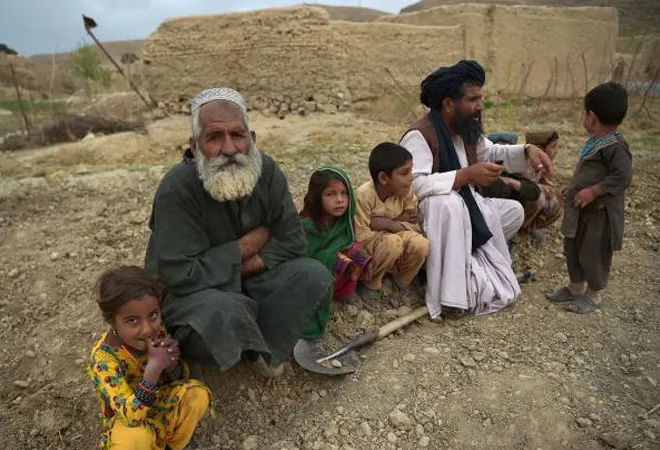
The Afghans make up the third-largest refugee population in the world after Syrians and Venezuelans. There are an
estimated 2.6 million registered Afghan refugees globally, of which 2.2 million reside in Iran and Pakistan alone. Afghanistan has returned to one of the darkest times in its history.
The Taliban administrators have failed to rebuild Afghanistan, thus far, making it difficult to govern. Its inability to form an inclusive government to provide girls and women with the right to education and work and its efforts to restrict people’s mobility have led to a new Afghan refugee crisis. This coupled with a continued drought has compounded the humanitarian crisis, increasing the number of people willing to flee, especially to the neighbouring countries.
The dispute arose due to a disagreement over road construction by the Taliban near the border and led to the temporary closing of the crossing and the seizure of an Iranian military vehicle.
The Taliban’s recent border skirmishes with Iranian and Pakistani authorities have added to the struggles of Afghans seeking refuge. Both neighbouring countries fear an influx of refugees and the export of extremism. The new Afghan administrators are incapable to address their concerns causing further instability.
Simmering border tensions with Iran
Tehran was quick to accept the reality of the Taliban takeover and adopted a rather pragmatic approach toward the new administrators of Afghanistan. Recent confrontations on the border, however, renewed hostilities between Iran and the Taliban. The
dispute arose due to a disagreement over road construction by the Taliban near the border and led to the temporary closing of the crossing and the seizure of an Iranian military vehicle. This is the second time the two sides have engaged in border skirmishes since the Taliban's takeover in Kabul last August.
Iran’s 900-km border with Afghanistan has always raised concerns about an influx of refugees, smuggling, and drug trafficking. The Iranian government estimates that approximately 500,000 Afghans have arrived in Iran in 2021. Up to 5,000 people arrive daily in
the aftermath of the takeover, compared to 1,400-2,500 on average beforehand. Tehran faces diminishing resources to support Afghan refugees as it suffers under the weight of the United States (US)-led sanctions.
The Iranian diplomatic mission in Kabul and Herat suspended all services in light of a group of Afghan protestors throwing rocks at the missions.
A major concern is the mistreatment and exploitation of Afghan refugees in Iran. Last month, the Iranian diplomatic mission in Kabul and Herat
suspended all services in light of a group of Afghan protestors throwing rocks at the missions. The protests were
sparked by the videos circulating of harassment and humiliation of young refugees by Iranians. This is an indication that relations between the Taliban and Iran are sensitive and mere engagement between the two has yielded limited results. Tehran may have condoned the insurgent group’s leadership but is still apprehensive of the hardline elements in the organisation. Especially in light of the Taliban’s demonstrated failure in preventing attacks by the Islamic State Khorasan Province (ISK-P) against the minority Shia community over the last months.
Iran has long exploited the vulnerable Afghan population. Afghans who manage to cross over to Iran via smuggling route face discrimination and limited job opportunities. Additionally, Iran recruits Afghan asylum seekers to travel to Syria, making martyrs of Afghan refugees. In desperate need of money or a residence permit—or both, many eligible Afghan men are coerced to
sign up for combat in Syria for which they are paid 500 US $ with the promise of basic schooling or university education and better living conditions for their families. Mostly deployed for special operations outside Iran, the Fatemiyon division is made up of Afghan fighters who belong to the Iranian Quds Force, an elite unit of the Iranian Revolutionary Guard.
The undocumented Afghans’ situation is in stark contrast to registered refugees. With extreme restrictions on livelihood, access to education and healthcare, they are under the constant threat of abuse and deportation by Iranian authorities. Since January, between 2,500 and 3,000 Afghans are being deported every day via border crossings from Iran. This number will only increase in the coming weeks with the escalation of tensions at the Iran–Afghanistan border. There has also been rampant abuse of refugees where the dead bodies of Afghans have been
returned with missing kidneys and other organs from Iran.
With extreme restrictions on livelihood, access to education and healthcare, they are under the constant threat of abuse and deportation by Iranian authorities.
The Iranian government has been shouldering a heavy burden of dealing with refugees from Afghanistan for 40 years without much international humanitarian assistance, unlike Pakistan. Nevertheless, the scant international cooperation and fragile economy are no excuse for Iran’s overt exploitation of Afghans.
Strained ties with Pakistan
Pakistan hosts
more than 1.4 million registered refugees from Afghanistan. An
estimated 5,500 Afghans arrived between 27 August to 29 September in 2021, with 60 percent of them living in Khyber Pakhtunkhwa province. Afghans now face increasing pushback as Pakistan tightened border restrictions and increased deportations. Recently, the police in Khyber Pakhtunkhwa arrested several Afghan artists for deportation. This sparked protest in Peshawar as they claimed their lives were in danger in Taliban-ruled Afghanistan.
Often the Afghan refugees are used as scapegoats by the Pakistani government in times of economic uncertainties. Apart from the economic burden of hosting refugees, Islamabad has been paranoid about its national security. Pakistan has sought to complete the border fencing, something even previous Afghan governments never accepted. Early this year, there were clashes between Pakistani and Taliban security forces related to Pakistan’s
fencing of the border. Such border skirmishes have significantly restricted the movement of people across the border.
In what led to an unexpected rift between Islamabad and the Taliban,
Pakistani airstrikes in April on the bordering provinces Khost and Kunar have added to the regional pressures. Unhappy with the Taliban’s lack of ‘stern actions’ against the Tehrik-e Taliban Pakistan (TTP), Islamabad’s military operation was in response to increasing attacks from Afghan soil leaving
47 civilians dead. In Pakistan, TTP has carried out 82 attacks and has killed 133 people since the US-backed administration collapsed. The Taliban is clearly maintaining ties with anti-Pakistan groups like the TTP to have leverage over Islamabad as it attempts to drift from Pakistan’s sphere of influence.
Afghanistan under the Taliban is facing the worst humanitarian crisis with 97 percent of the population at the brink of universal poverty by next month.
The recent strains in relations are indicative of a decline in Pakistan’s historical strategic depth and leverage over Afghanistan. Taliban’s top leader, Anas Haqqani, recently
expressed that “Afghanistan’s doors are open for India’’. This is particularly encouraging as India has been an active regional power.
Conclusion
Pakistan is facing major economic challenges and political turmoil, whilst Iran’s economy has been crippling due to western sanctions. Afghanistan under the Taliban is facing the worst humanitarian crisis with
97 percent of the population at the brink of universal poverty by next month. Ordinary citizens of Afghanistan are not responsible for the horrors and the Taliban is incapable of delivering what is required. The chaotic images of a panicked mob at the Kabul airport on 15 August 2021 showcased the lack of confidence in Taliban governance.
The USand its allies have a profound responsibility to assist Afghans, however, with the Russian invasion of Ukraine, the plight of Afghans has been forgotten. Thus, the need of the hour is for the regional actors like Central Asian states and India to address the Afghan refugee crisis by building sustainable and coordinated mechanisms which can ensure the resettlement of the vulnerable.
The views expressed above belong to the author(s). ORF research and analyses now available on Telegram! Click here to access our curated content — blogs, longforms and interviews.



 The Afghans make up the third-largest refugee population in the world after Syrians and Venezuelans. There are an
The Afghans make up the third-largest refugee population in the world after Syrians and Venezuelans. There are an  PREV
PREV


